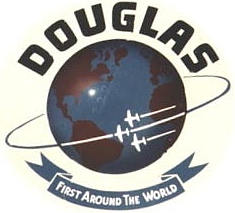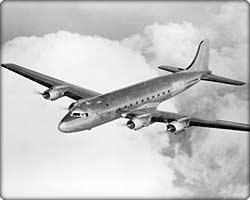
The Douglas DC-4 Association
of South Africa
A brief history of the Douglas DC-4/C-54
| DC-4 South African Operators |
|
|
|
|

Information courtesy www.boeing.com
Douglas decided to produce a four-engine transport about twice the size of the DC-3 and, in 1938, developed the single DC-4E to carry 42 passengers by day or 30 by night. It had complete sleeping accommodations, including a private bridal room.
It proved too expensive to maintain, so airlines agreed to suspend development in favor of the less complex DC-4, but it was not put into commercial service until 1946. Its military derivative was the C-54 "Skymaster" transport, ordered by the U.S. Army Air Forces in 1942.
Douglas built 1,241 of the DC-4s and its military counterparts, including the R5D for the Navy. During the war, C-54s flew a million miles a month over the rugged North Atlantic -- more than 20 round trips a day. A special VC-54C, nicknamed the "Sacred Cow" by the White House press corps, became the first presidential aircraft, ordered for Franklin D. Roosevelt.
In the years immediately following the war, new DC-4s and used C-54s carried more passengers than any other four-engine transport. Some were still flying through 1998.
After World War II, commercial airlines placed more than 300 civilian DC-4 transports into service.
| First flight: | Feb. 14, 1942 |
|---|---|
| Model number: | DC-4 |
| Span: | 117 feet 6 inches |
| Length: | 93 feet 5 inches |
| Height: | 27 feet 7 inches |
| Power: | Four 1,450 horsepower Pratt & Whitney R-2000 "Twin-Wasp" engines |
| Weight: | 82,500 pounds |
| Operating altitude: | 10,000 feet |
| Range: | |
| Speed: | 207 mph |
| Accommodation: | 44 to 80 passengers |
Variants
| DC-4-1009 |
Post WWII passenger |
| DC-4-1037 |
Post WWII freighter |
| C-54 |
DC-4M North Star -
71 DC-4s were built by Canadair under the designations North Star, DC-4M,
C-4, and C-5. With the exception of the single C-5, these were all powered
by Rolls-Royce Merlin engines and 51 of them were pressurized. The Royal
Canadian Air Force, Trans-Canada Air Lines, Canadian Pacific Air Lines and
BOAC operated these aircraft, the latter under the type name
"Argonaut".
Aviation Traders Carvair -
Starting in 1959, 21 DC-4s and C-54s found new life as ATL-98 Carvairs.
The Carvair was designed to carry 22 passengers and 5 automobiles. This
was accomplished by extending the fuselage, moving the cockpit above the
fuselage, adding a side-opening nose, and enlarging the vertical
stabilizer to offset the larger forward fuselage. These planes served as
flying ferries well into the seventies, and two are still airworthy as of
March 2008 - one each in Texas and South
Africa.